Contributory members are able to log private notes and comments about each site
Sites Anne T has logged. View this log as a table or view the most recent logs from everyone
Midshiels Standing Stone
Trip No.93 Entry No.6 Date Added: 31st Aug 2018
Site Type: Standing Stone (Menhir)
Country: Scotland (Scottish Borders)
Visited: Yes on 29th Aug 2018. My rating: Condition 3 Ambience 4 Access 4

Midshiels Standing Stone submitted by Anne T on 4th Jun 2017. This is the nearest we could get to the standing stone on the evening of our visit. The field was full of quietly grazing sheep but many lively, curious young bullocks. The minute we started to open the gate, they were racing towards us.
(View photo, vote or add a comment)
Log Text: Midshiels Standing Stone, near Hawick: At our last visit, we were put off from entering the field because of a very large bull and his ladies. The bull stood guard near the stone, and any approach made him stand tall, with splayed legs, looking menacingly at us – I contented myself with taking photos from near the gate in the field.
At this visit we parked near the entrance to Midshiels farm, at NT 53459 17603, where we made sure we weren’t blocking the entrance into field. Immediately opposite, at NT 53461 17624 is a metal gate into the field, with the top of the stone just visible.
Husband, Andrew, opened the gate and was in the field, and I was just about to follow when a loud voice behind me stopped me going an further. There was a large, but friendly, farmer and his lad in a very large pickup truck. “There are bullocks in that field – if they see you, they’ll go for you. Drive into the next field and go up to the tunnel – you can turn round there. You can see the stone from there.” I thanked him for the ‘heads up’.
Andrew moved the car, but rather than drive the car up to the tunnel, the ground was a bit too uneven to risk the bottom of the car, so we left it at the edge of the field at NT 53518 17745 and walked to the gate near the tunnel at NT 53388 17830. From here, it looked as if all the cattle were at the far end of the field, with many of them lying down, although the hump in the middle of the field made it difficult to really see. We decided to take the chance and walk to the stone, as we could have got back to the gate quickly.
This stone was glorious in the sunshine, with a most peculiar small ‘hook’ to the top. I tried to capture the shadow in the strong sunshine.
Cavers Cross
Trip No.93 Entry No.5 Date Added: 31st Aug 2018
Site Type: Ancient Cross
Country: Scotland (Scottish Borders)
Visited: Yes on 29th Aug 2018. My rating: Condition 2 Ambience 4 Access 5
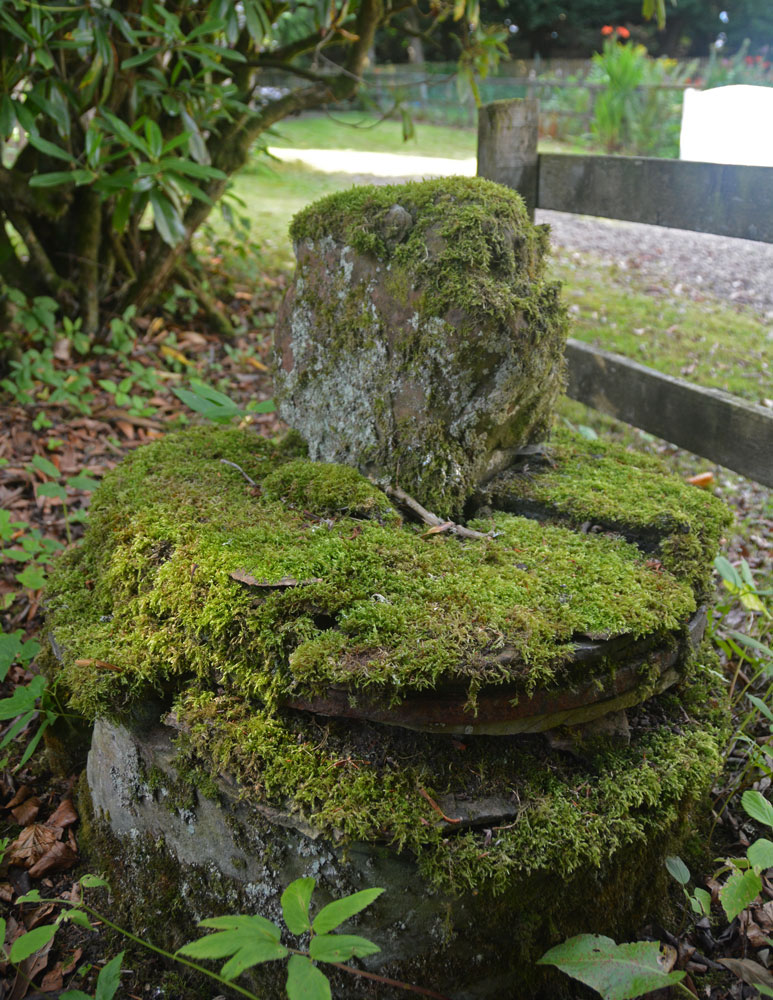
Cavers Cross submitted by Anne T on 31st Aug 2018. A view looking across the cross to the north, towards the small 'cross roads' in the centre of the hamlet of Cavers. The base is round but in pieces which have been stacked on top of each other, held together in places by old metal staples.
(View photo, vote or add a comment)
Log Text: Cavers Cross, near Hawick: From the motte, we drove round to Cavers – a very nicely kept estate, with well kept verges and few places to park along the straight, narrow road by the houses. In the end, we pulled right up to the fence at the largish entrance to a field gate at NT 54235 15805, intending to run back to the car if anyone thought we were in the way.
Walking south west towards the houses (I didn’t even recognise the Auld Kirk, as its been converted into a house with large driveway), we couldn’t see anything resembling a cross. There was a lady who was painting her fence and her large dog, who barked at us and sniffed my hands. I asked her if she knew of the remains of the cross, and she said, “Yes, but it’s only small”. She showed us where it was ‘hiding’ – behind a fence and shrubs in deep shade, then behind its own wooden fence, now much broken. She gave us permission to go into the garden of the holiday cottage as there was no-one there at the time of our visit. Whilst the Canmore record mentions the base of the cross (with the metal bands much visible), nothing is mentioned about the shaft it currently holds. This is of red sandstone and shaped, although much moss-covered.
Moving a small bit of stone near the join of the shaft and the base, there is evidence of a straight cut for part of the socket hole. We didn’t’ see any dowel holes, as the surface was moss and twig covered, but then the report that mentions this is dated 1933!
Fast Castle (Bedrule)
Trip No.93 Entry No.4 Date Added: 31st Aug 2018
Site Type: Misc. Earthwork
Country: Scotland (Scottish Borders)
Visited: Yes on 29th Aug 2018. My rating: Condition 2 Ambience 4 Access 4

Fast Castle (Bedrule) submitted by Anne T on 31st Aug 2018. Our first view of this large earthwork/motte through the trees from the minor road from Bedrule to the Jedburgh Road.
(View photo, vote or add a comment)
Log Text: Fast Castle/Bedrule Motte: Not far from Bedrule Church this motte is marked on the map. At first it just appeared as a mound behind some trees, and we weren’t going to stop, until we realised the tree cover finished and the motte was clearly visible from the track going to Bedrule Mill. We let ourselves in through the gate and stopped to photograph this impressive mound. It sits by a bend in the very pretty river Rule.
Bedrule Parish Church
Trip No.93 Entry No.3 Date Added: 31st Aug 2018
Site Type: Sculptured Stone
Country: Scotland (Scottish Borders)
Visited: Yes on 29th Aug 2018. My rating: Condition 3 Ambience 4 Access 5

Bedrule Parish Church submitted by Anne T on 31st Aug 2018. A close up of the longer, almost rectangular hogback fragment, described as (2) in the Canmore record: "A fragment of a hog-backed tombstone measuring 1 ft. 3 1/2 in. in length by 7 in. thick, each side being 7 1/2 in. broad and showing three rows of shingle pattern."
(View photo, vote or add a comment)
Log Text: Hogback fragments, Bedrule Parish Church: (note for less mobile visitors, whilst access into the churchyard is on a tarmacked path, there are some steps up into the porch where these fragments are stored. Disabled access is signposted but the door was locked at the time of our visit). This parish church is in the tiny hamlet of Bedrule. We could see the church from the minor road, but had to go virtually through the village and turn south past a row of small cottages to reach the church. There was a small car park outside the churchyard gates. Rubens Law is to the south and dominates the view, which is rather nice.
The western side of the churchyard is divided into a series of ’garden rooms’, each with a small collection of interesting, old grave slabs, some dating to the 1650s.
The hogback fragments were inside the porch, along with a small stone with recumbent, robed figure. The fragments were underneath the small table with prayer and hymn books, so we moved the table out of the way (and replaced it), to photograph the fragments.
Hawthornside Farm (Bonchester Bridge)
Trip No.93 Entry No.1 Date Added: 31st Aug 2018
Site Type: Holy Well or Sacred Spring
Country: Scotland (Scottish Borders)
Visited: Yes on 29th Aug 2018. My rating: Condition 3 Ambience 3 Access 5
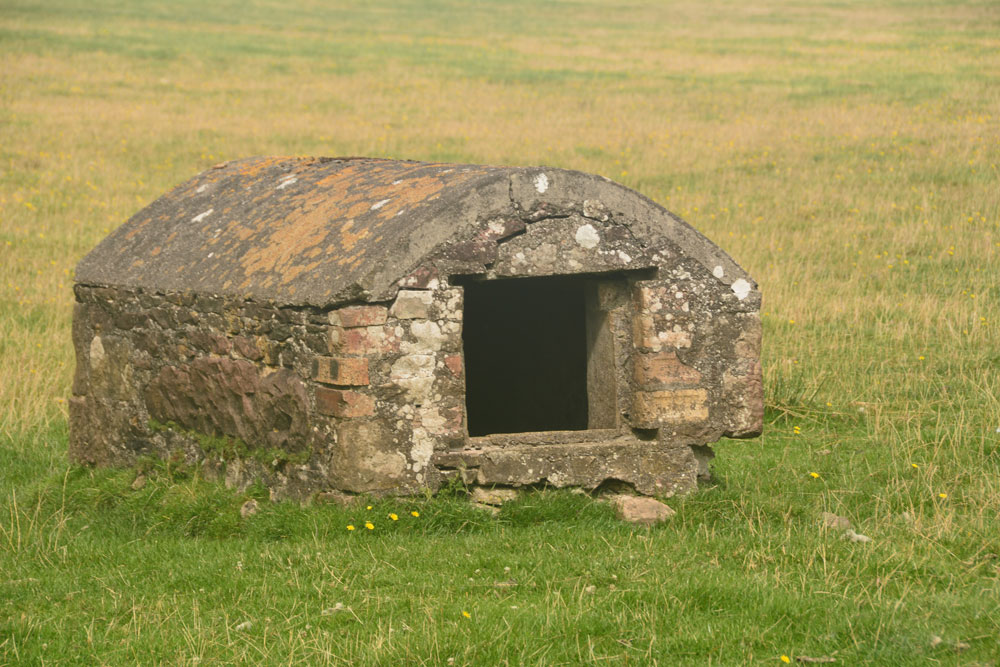
Hawthornside Farm (Bonchester Bridge) submitted by Anne T on 31st Aug 2018. This 'well house' is marked as a tank on the Canmore map, although the structure looks old and the chamber holds clear water. I'd love to know more about this well/tank if anyone has any information. We spotted it by chance trying to find our way to Bedrule.
(View photo, vote or add a comment)
Log Text: Well/tank, Hawthornside Farm (Bonchester Bridge): We spotted this ‘well house’ purely by chance as we passed by, then needing to turn the car round to go to Bedrule Church with its hogback fragments. This is a lovely site, right by the A6088. The well house (or ‘sink’ as it is labelled on the Canmore map) has Rubers Law Hillfort in the background.
There is no mention of Canmore, apart from the word ‘tank’ on its large scale map. The water appears to come straight up into the well basin – there is no sign of a pipe in or out. It does have the hinges for a (presumably wooden) door, which is no longer there. The water was beautifully clear and the inside of the structure clean.
Todley Hill Mound (Great Whittingham)
Trip No.92 Entry No.2 Date Added: 21st Aug 2018
Site Type: Misc. Earthwork
Country: England (Northamptonshire)
Visited: Yes on 21st Aug 2018. My rating: Condition 3 Ambience 4 Access 4
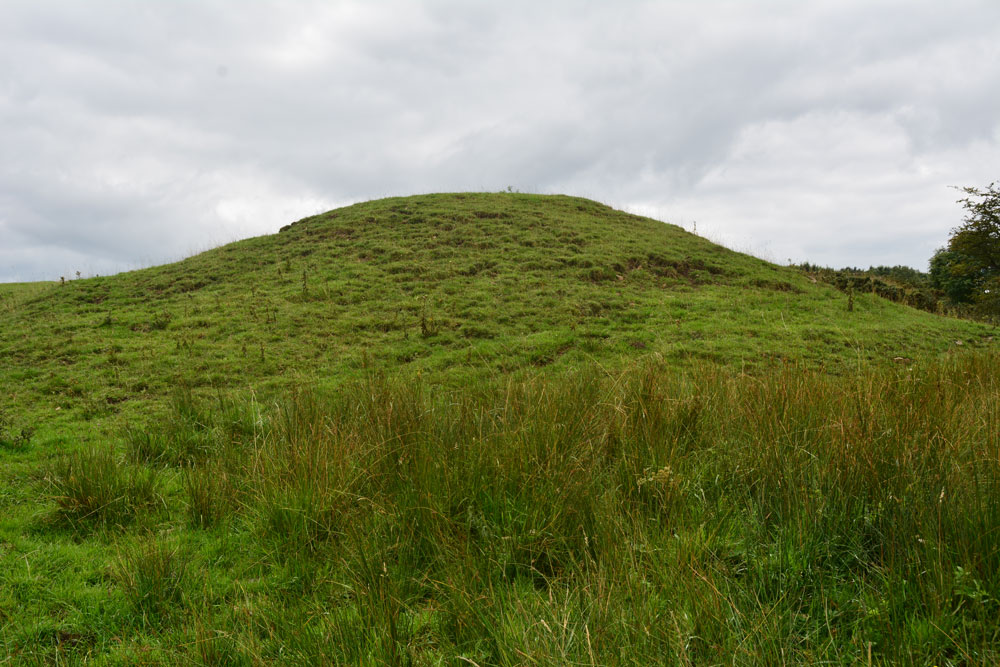
Todley Hill Mound (Great Whittingham) submitted by Anne T on 21st Aug 2018. Standing by the small ford across the stream to the north of the mound, looking south as the mound rises high above us.
(View photo, vote or add a comment)
Log Text: Todley Hill Mound, near Great Whittingham: Walking back to the car, we saw a couple of vans with trailers belonging to the farmers, and I was looking for someone to ask permission to enter the field to see the mound, but whilst the trailer doors were left wide open, no people were visible. There was a gate into the field at NY 99675 71602, almost opposite where we’d parked the car, but there was a stream in the way. We opted to drive further back up the road, and parked at NY 99488 71218, where the road widens out into a large field entrance and dump for roadstone.
The gate into the field had been chained shut, so we walked back down the road and found part of the fence we could hop over.
This is a large mound, in a pretty spot with a small stream to its northern side. There appeared to be a large earth-fast boulder towards its south western side, with smaller boulders surrounding it, but the latter had been broken and were probably field clearance.
Walking round the mound, it appeared to us to have vague traces of a kerb with boulders/stones poking through, mainly on its southern and eastern sides.
This mound/tumulus/barrow is right on the old Roman Road, the Devil’s Causeway, jus to the east of where this cuts the modern road. The vague remains of an edge of this road can be seen (possibly) in the field opposite, to the south of the small stream (or it maybe modern uplift from dredging the stream).
This really had the feel of a barrow to me, and I enjoyed walking round it.
Brandy Well (Great Whittingham)
Trip No.92 Entry No.1 Date Added: 21st Aug 2018
Site Type: Holy Well or Sacred Spring
Country: England (Northumberland)
Visited: Yes on 21st Aug 2018. My rating: Condition 3 Ambience 4 Access 4
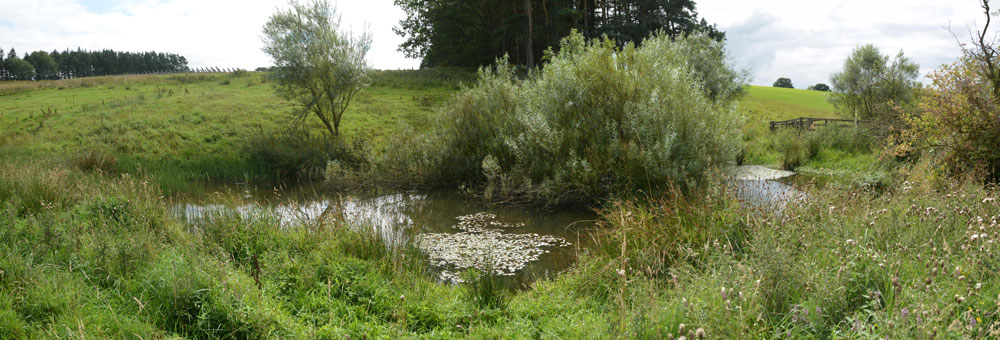
Brandy Well (Great Whittingham) submitted by Anne T on 21st Aug 2018. This panorama of the well pool is taken from just over the wooden footbridge at its north western side. A very peaceful, lovely spot.
(View photo, vote or add a comment)
Log Text: Brandy Well, Todridge Farm, near Great Whittingham: We decided to stop off here on our way to Carlisle to look for this unusually named holy well, near The Queens Arms pub/Chinese restaurant we’ve been to several times. We parked at NY 99652 71590, on the verge before the entrance to Todridge Farm. The farm is more than just a farmhouse and a barn – it’s a hamlet with a number of houses.
Following the track to NY 99143 71795, there is gate into the field on the right hand side (the footpath sign has worn away, it’s just a small white plaque), and we followed this diagonally across the field to the end of the wood, passing a small solar energy ‘farm’ to our right hand side. At about NY 99084 71982 there is a small wooden gate with a footpath sign on it, but this was firmly tied up with a number of ropes (the hinges had broken), so we used the larger gate into the field, and walked a few tens of metres down the slope to the bridge.
On the bridge, you can hear water trickling at the edge of the pool; looking down, there is a dam which lets water out into the stream beyond. Having photographed the well pool from the bridge, we walked up to the land bridge/tractor track at NY 99134 71998 and turned left towards the northern side of the pool. There, in the corner of the fence, we could see the remains of a stone structure, now fallen into what looked like an extension to the pond, where people used to pull water out of.
This is a very pretty spot and a very pretty, if now overgrown, pond, full of waterlilies.
Kilmartin Churchyard (Poltalloch Enclosure)
Trip No.87 Entry No.18 Date Added: 20th Aug 2018
Site Type: Sculptured Stone
Country: Scotland (Argyll)
Visited: Yes on 17th Jul 2018. My rating: Condition 3 Ambience 3 Access 4
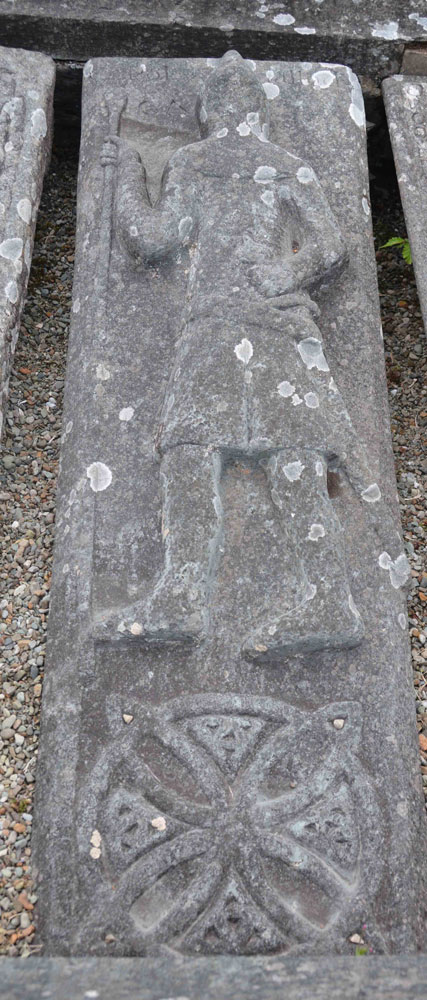
Kilmartin Churchyard (Poltalloch Enclosure) submitted by Anne T on 20th Aug 2018. This tapered slab, in the Poltalloch Enclosure, measures 1.85m by 0.59m. It has an armed figure above a large ring-knot with triquetra knots in the interspaces. At the top there are the added names POLTALLOCH and CA (?MPBELL). Loch Awe School. Dates to the 14th to 15th century.
(View photo, vote or add a comment)
Log Text: The Poltalloch Enclosure, Kilmartin churchyard: See main report for Kilmartin churchyard (MP 87.18).
Kilmartin Churchyard (Lapidarium)
Trip No.87 Entry No.18 Date Added: 20th Aug 2018
Site Type: Sculptured Stone
Country: Scotland (Argyll)
Visited: Yes on 17th Jul 2018. My rating: Condition 3 Ambience 4 Access 4
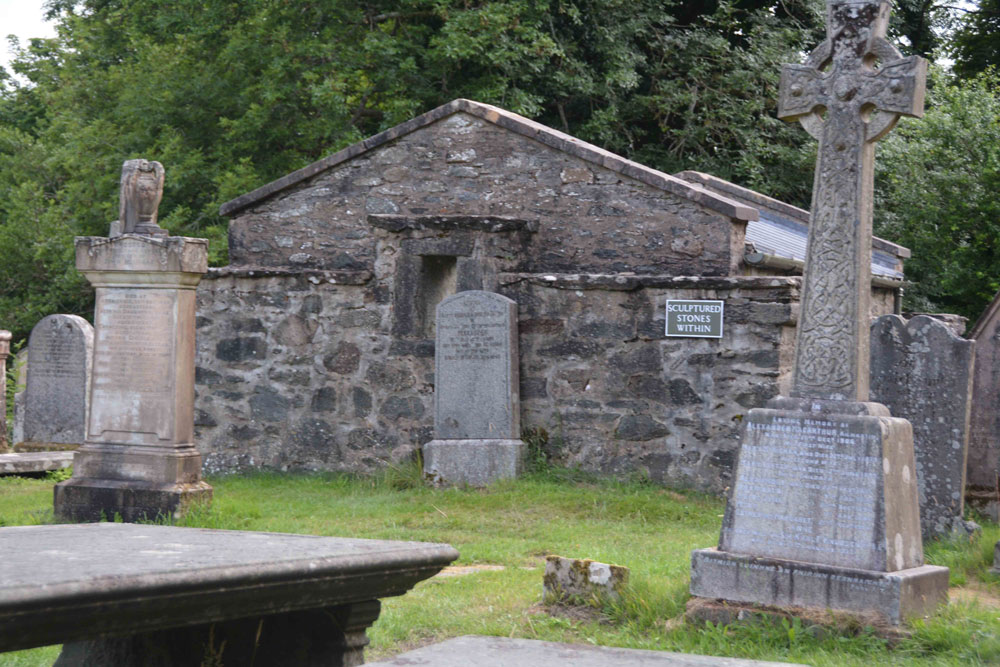
Kilmartin Churchyard (Lapidarium) submitted by Anne T on 20th Aug 2018. The lapidarium, as seen from the path to the left hand side of Kilmartin Church (entering from the main gate by the car park by the A816 opposite the Kilmartin Arms/Hotel).
(View photo, vote or add a comment)
Log Text: Kilmartin Church (Lapidarium): See visit report for Kilmartin Churchyard (MP87.18)
St Bridget's Church (Brigham)
Trip No.91 Entry No.7 Date Added: 18th Aug 2018
Site Type: Ancient Cross
Country: England (Cumbria)
Visited: Yes on 14th Aug 2018. My rating: Condition 3 Ambience 4 Access 5
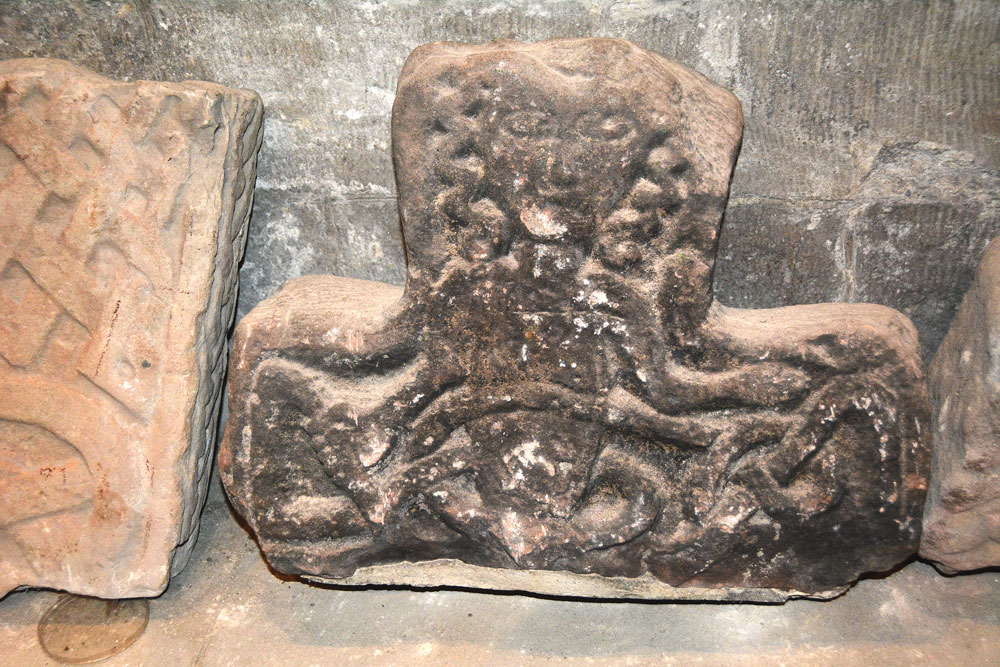
St Bridget's Church (Brigham) submitted by Anne T on 18th Aug 2018. This is Brigham 05, part of a cross-head dating to the 10th century. It was first recorded in 1881, presumed to have been found in restorations of 1864 or 1875-6. Note the curly haired naked figure, with his right hand and a snake (or interlace) bound across his stomach. His left hand is described as having an open palm, lying above the interlace of the right arm.
(View photo, vote or add a comment)
Log Text: St Bridget's, Brigham (Anglo Saxon Stones): Whilst this church looks very austere from outside, and the entrance doors dark and foreboding, once inside the church, it is a completely different picture – this church is light, airy and welcoming. The painted ceilings are fantastic.
The church warden turned up as arranged, and was so welcoming. He sought out a guide to the church and old postcards for information, then left me photographing the stones whilst Andrew walked round the church with him.
Time was all too short here, and I could have spent another hour, but we knew the church warden needed to get home, and the evening traffic was building up outside. In our haste, we missed Brigham 13, a cross base at the west end of the church (I thought I’d photographed it, as we went through all the AS Corpus pages I’d brought with me, but realised (too late) it wasn’t the correct stone).
After looking at the Fletcher family grave (now very worn and held together with large staples, I walked over to the west end of the churchyard to look at the farmhouse, which used to be the rectory for the farm).
We also looked for the site of Nun's Well, but were unable to see anything.
Chantry Well (Brigham)
Trip No.91 Entry No.6 Date Added: 18th Aug 2018
Site Type: Holy Well or Sacred Spring
Country: England (Cumbria)
Visited: Yes on 14th Aug 2018. My rating: Condition -1 Ambience 2
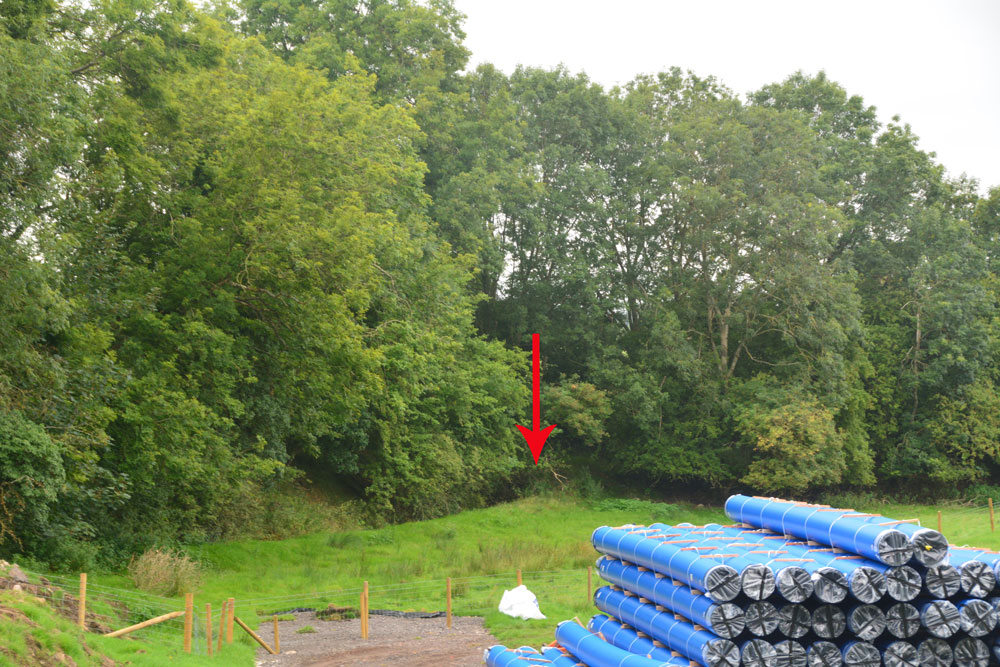
Chantry Well (Brigham) submitted by Anne T on 16th Aug 2018. This is the approximate site of the Chantry Well, as pointed out by the church warden of St. Bridgets, and as recorded by Pastscape Monument 9025 and the Old Cumbria Gazetteer. A new mains water pipeline is being driven through the field, although it was previously recorded the well was destroyed by quarrying. Some marshy ground still remains fenced off in the corner by the red arrow.
(View photo, vote or add a comment)
Log Text: Chantry Well, Brigham (Destroyed) The Reverend Mary told us there was a holy well at Brigham. There are actually 2 listed – Chantry Well and Nun’s Well, next to the A66.
Mr. Furness, the church warden also mentioned the well, but said it was no longer there. In the field opposite the church, a new water pipeline is being constructed. In the field to the south a new housing estate is also being built. There is no access into the field because of the building works, but the grid reference gives a point where the tree line bends.
St Mungo's Well (Cumbria)
Trip No.91 Entry No.8 Date Added: 18th Aug 2018
Site Type: Holy Well or Sacred Spring
Country: England (Cumbria)
Visited: Yes on 14th Aug 2018. My rating: Condition 3 Ambience 4 Access 4
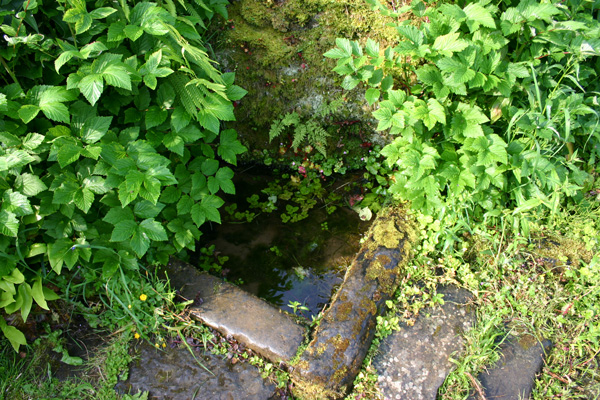
St Mungo's Well (Cumbria) submitted by ocifant on 26th Jun 2005. Looking at the various maps, the location of this well is difficult to discern. It's actually easy to find once you get to the church though.
From St Kentigern's in Caldbeck, walk through the churchyard from the road, and exit via the rear gate. Cross the footpath to the river. Immediately on entering the river path, there are a couple of steps down to the riverbank. These lead to the well.
(View photo, vote or add a comment)
Log Text: St Kentigern's Well, Caldbeck: This was our last stop of the day, and to a part of Cumbria we've never travelled through before. From St. Bridget's in Brigham, we followed the B5299 to Caldbeck village, which took us over cattle grids and moorlands, with only sheep and the occasional other car in sight.
Caldbeck is a really pretty little village, and we resolved to come back during the daytime, when the shops, church and café were open.
The well can be easily found by walking down the footpath to the west of the church, until you get to the bridge over the river. As it says in the "Holy Wells of Cumbria" booklet, turn left just before the bridge, and you immediately come to some steps down the (steep-ish) bank to the river. We heard the trickle of water down the slope, and the well basin comes into view as you look down. At the time of our visit the water missed the basin and was trickling down the rock, under the shrubbery, into the river. There was a fair flow of water coming down the bank.
We walked along the footpath along the northern side of the churchyard for about 100mand found a lovely weir with small waterfalls. It was possible to walk down to the gravel beach. A lovely spot indeed.
St Bridget's Church (Bridekirk)
Trip No.91 Entry No.5 Date Added: 18th Aug 2018
Site Type: Ancient Cross
Country: England (Cumbria)
Visited: Yes on 14th Aug 2018. My rating: Condition 3 Ambience 4 Access 5
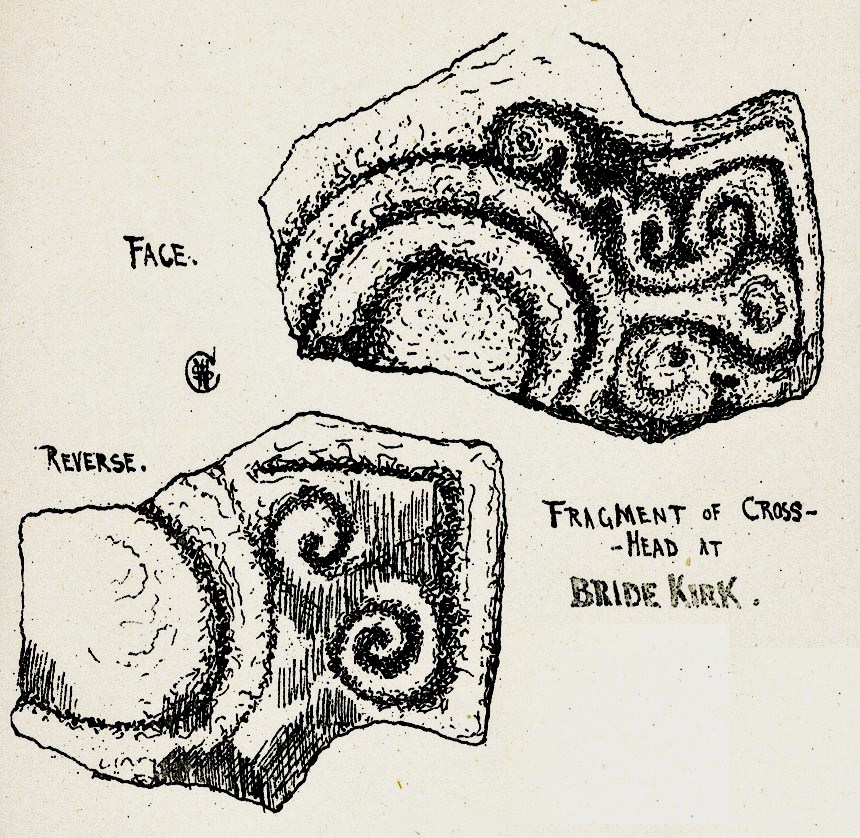
St Bridget's Church (Bridekirk) submitted by Sunny100 on 19th Apr 2011. Illustration of The Cross-Head fragment at St Bridget's Church, Bridekirk, Cumbria, by Rev William Slater Calverley 1847-98.
The above image is from his renowned work 'Early Sculptured Crosses, Shrines and Monuments in the Present Diocese of Carlisle 1899 Ed. by W.G. Collingwood.
(View photo, vote or add a comment)
Log Text: Font with Runic inscription, St. Bridget's, Bridekirk: We had an hour to fill between appointments between churches, so headed off to Bridekirk to see the font with runic inscription, which we'd missed during our last visit on 1st May 2015. The notice said the church was "normally open during daylight hours" but on this occasion the main door appeared to be bolted at the top from the inside, so we couldn't get in. This time, not having a six month old granddaughter with us, we walked round the outside of the church and noticed a collection of old grave slabs displayed against the exterior of the apse at the east end of the church, including an old cross base. None of these in mentioned on Pastscape.
Checking back in my photos, I had taken a photograph of the font. The middle band (when enlarged) does indeed have a runic inscription on it.
Kilmartin House
Trip No.88 Entry No.10 Date Added: 18th Aug 2018
Site Type: Museum
Country: Scotland (Argyll)
Visited: Yes on 18th Jul 2018. My rating: Condition 4 Ambience 4 Access 5
Kilmartin House submitted by DrewParsons on 29th Jun 2010. Located in the middle of the village of Kilmartin, the museum has a good display of local finds and interesting descriptions of the prehistoric sites in the neighbourhood. There is also a well stocked museum shop on the premises.
(View photo, vote or add a comment)
Log Text: Kilmartin Museum: We managed to get a space in the car park. From the number of cars parked outside the museum and along the roads, we thought the place would be heaving with people (including a bus tour which had turned up), but the café was quiet and relaxing and there was only one other lady and a younger man who was with her, in the museum.
The museum was small, and a bit disappointing for the £7 entry fee, but it was nicely laid out and they gave you a map of the sites to visit. The lady on reception told us we were allowed to take photographs, but as long as they were not for publication on the internet.
I bought 4 postcards and “In The Footsteps of Kings” book of walks around the Kilmartin area, which gave a lot of information about the area, together with photographs and what to look for, which helped inform our visits greatly – wonderful photos in it, too!
I photographed Glebe Cairn from the path running outside the conservatory.
I have since been in contact with the Visitor Services Office, at the museum, and received the following reply on 14th August 2018 (see private notes).
St John The Evangelist (Crosscanonby)
Trip No.91 Entry No.3 Date Added: 17th Aug 2018
Site Type: Ancient Cross
Country: England (Cumbria)
Visited: Yes on 14th Aug 2018. My rating: Condition 3 Ambience 4 Access 5
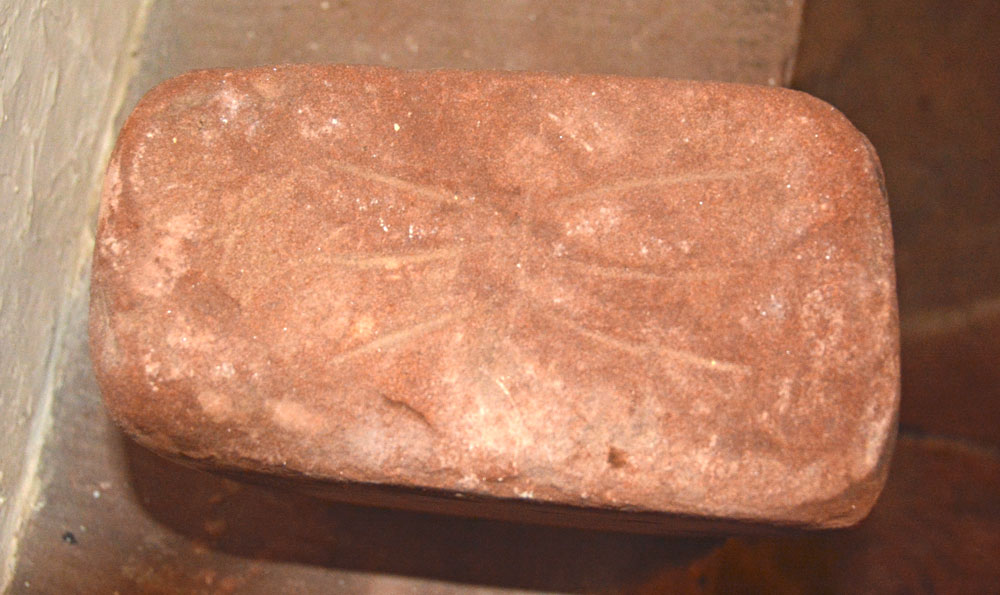
St John The Evangelist (Crosscanonby) submitted by Anne T on 17th Aug 2018. Face D of AS Corpus Cross Canonby 03, also known as The Thunder Bolt Stone. The Corpus tells us this face shows: "the incised ornament consisting of a single horizontal line on which converge three incised lines from above and below." This is the famous 'thunder bolt' symbol.
(View photo, vote or add a comment)
Log Text: St John The Evangelist, Crosscanonby: We had arranged to meet the Reverend Mary at the church at 2pm. Between Gilcrux and here we had an hour to spare, so went into Cockermouth for lunch and a quick walk round the town. Travelling through Dearham and across the A596 to Crosscanonby, as we dropped down a small hill after having crossed the A596, we realised how close this church is to the Solway Firth (according to UK Grid Finder measurements its 900m).
This little church is side on to the road, and is virtually invisible until you reach the gate into the churchyard, although the ‘this church is open’ board gave something away.
I’d not looked at the AS Corpus notes I’d brought, but straight away we spotted the hogback against the south eastern corner of the nave.
Walking inside was a real treat. This is clearly a very old building. Reverend Mary (just ‘Mary’ she said) told us this church used to be the mother church for Maryport and the farm house next door (to the west of the church) used to be part of the monastery; the monks used to process from the monastery to the church; rumour has it there is a tunnel from the farmhouse to the church, but it’s never been found.
The church is pretty special, although I focussed on photographing the stones in the porch whilst Andrew spoke to Mary about the structure of the building, as I was conscious of taking up Mary’s time and we needed her to come across to Dearham to open the vestry for us. I’d love to go back and spend more time here.
St Mungo's Dearham
Trip No.91 Entry No.4 Date Added: 16th Aug 2018
Site Type: Ancient Cross
Country: England (Cumbria)
Visited: Yes on 14th Aug 2018. My rating: Condition 3 Ambience 4 Access 5
St Mungo's Dearham submitted by coin on 29th Mar 2017. The Viking Cross at Dearham
(View photo, vote or add a comment)
Log Text: St Mungo's Church, Dearham: AS Corpus Dearham 03 and The Adam Stone: This was a return visit. pre-arranged with the lovely Reverend Mary, who drove from Crosscanonby to very kindly unlock the door of the vestry to show us AS Corpus Dearham 03, part of a cross-head.
We also saw the Adam Stone. Mary moved the knitted figures of Jesus and Peter and invited me to climb on the pew to get a better photograph. We felt so welcome, we didn’t really want to leave!
St Mungo's Dearham
Trip No.81 Entry No.5 Date Added: 16th Aug 2018
Site Type: Ancient Cross
Country: England (Cumbria)
Visited: Yes on 9th Jul 2018. My rating: Condition 3 Ambience 4 Access 5
St Mungo's Dearham submitted by coin on 29th Mar 2017. The Viking Cross at Dearham
(View photo, vote or add a comment)
Log Text: Ancient Crosses and a Norman font, St Mungo's Church, Dearham: After having been to two other churches which had been firmly locked, this church was, thankfully open and very welcoming.
The church was packed full of knitted scenes from the bible, jewellery and books. We missed the Adam Stone, but are going back on 14th August, and have asked for permission to get into the vestry to see AS Corpus Dearham 03, a fragment of a wheel headed cross built into the wall.
We had to move quite a few items from the west window to photograph AS Corpus Dearham 02, and it took us ages to get everything back!
The Norman font, apparently carved from the cushion capital of a column, was really interesting.
There was no church guide book, although there was a postcard (30p) and a display board, which I took a few photos of.
The first notes on the display board say: “There can be no doubt that Dearham had a church during the Dark Ages, following the withdrawal of Roman Forces from Britain. Many pre-Norman sculptured stones displayed in the present church provide evidence that Christianity was prevalent during Anglo Saxon and Viking times. The Reverend William Slater Calverley was vicar of Dearham from 1877 until 1885 and was responsible for uncovering and displaying many of these stones. He worked tirelessly on restoring the church to much of the originality as possible during his period of incumbency. In 1880 it was recorded that he did not know to whom the church was dedicated, the original dedication having been lost. It was rededicated in 1935, as a result of the inspiration of the Reverend Canon Malcolm D. Grieve, to St. Mungo, a Scottish saint whose real name was St. Kentigern. In 1937 Canon Grieve was also responsible for the addition inside the church building, of a side chapel dedicated to the Holy Name. It stands at the east end of the north aisle.”
There is a section on the display called: “A brief look at the history of St. Mungo’s. It is believed that the original stone church dating back to the early 1100s was about 48 feet long in the shape of a long, low tunnel. During the Norman period parts were added and extended later in the Early English period. The tower was added probably early 14th century. The porch was also an addition to the original building covering the Norman doorway. The north aisle was a completely new addition during the 1882 restoration when Mr. Calverley enlarged the church. The vestry, at the east end, is an extension to the north aisle, the date being cut into the pillar of an arch. Built in the north wall of the vestry is the head of the “Kenneth Cross”. It was found near the east end of the church and built into the vestry wall curing restoration. The stained glass window behind the altar was given by Mr. John Wilson of Dearham and built in at the time of the 1882 restoration. The bell, which weights almost half a ton, was given by Colonel Sewell, whose family were seated at Brandlingill end of Hayborough. The ancient windows, dating back probably to 1150 were removed during the 1815 restoration and sadly lost to this day! Had they been lying about in 1880 Rev. Calverley would have restorated them to their rightful place, when he in turn removed the sash windows and inserted new ones fashioned in the style of the originals.”
The display says: “The magnificent wheel head cross (Viking cross) stands 5ft 4ins high and is carved with “Yggdrasil”, the Norse tree of the universe. It stood in the churchyard until 1900 and then brought into the church and placed in front of the organ.”
Another section reads: “The treasures of the Church include two stones found during 1882 restoration work. Standing 4ft high is the Adam stone, dating from AD 900, which depicts the Fall and Redemption of Man, with Adam and Eve hand in hand above a serpent. The Kenneth Cross shows the legend of the 6th century hermit, S. Kenneth, who was lame from birth and after his baptism cast away in a coracle. He was saved from the gales, and brought up by seabirds.”
The small door leading up into the tower was open, with a very narrow set of steps leading up. Not even Andrew fancied venturing up.
St Mary's Church (Gilcrux)
Trip No.91 Entry No.2 Date Added: 16th Aug 2018
Site Type: Ancient Cross
Country: England (Cumbria)
Visited: Yes on 14th Aug 2018. My rating: Condition 3 Ambience 4 Access 5

St Mary's Church (Gilcrux) submitted by Anne T on 10th Jul 2018. We may not have been able to see the Viking cross head and shaft fragment, but we did spot this underneath the window in the southern external wall of the sanctuary. The notes inside the church say it is the remains of a grave slab, recut for use as a lintel.
(View photo, vote or add a comment)
Log Text: St Mary's Church, Gilcrux: The little car park outside the church was full (3 cars and a Water Board van), so we had to park just west of the well and walk back to the church – only a little way. The church door was open for us this time.
This is a remarkable little church inside. At first site, the nave appears more like a Methodist chapel – at first glance. Then my gaze lit on the archway into the chancel, with a ‘squint’ over the right hand column and a chunk taken out of the eastern side of the left hand column. Walking into the chancel is very reminiscent of Escombe Saxon Church – this place is ancient and very peaceful.
The collection of stones was underneath a table against the south wall, near the porch, so we turned into furniture removers, carefully taking the notice board, vases and loose notices off the table, then moving the table to examine and photograph the pieces.
We managed to put together the pieces of the cross head and part of the shaft, and photographed two sides. One of the pieces left white, chalky marks on our hands, and is very white against the grey of the other two pieces. This is clearly the cast of the upper part of the cross head.
We closed the church door to indicate to the keyholder we’d been in and left again, and walked round to the north side of the church, where it is very obvious that the church has been built on a mound.
There was no church guide book, but there were some ‘notes for visitors’ which I photographed, and have typed into my walk journal.
The spring was in full flow, and it was lovely to hear it babbling away. Brilliant. Definitely worth a return visit.
St Mungo's Church (Bromfield)
Trip No.81 Entry No.1 Date Added: 15th Aug 2018
Site Type: Ancient Cross
Country: England (Cumbria)
Visited: Yes on 9th Jul 2018. My rating: Condition 3 Ambience 4 Access 4

St Mungo's Church (Bromfield) submitted by Anne T on 10th Jul 2018. The dark red semi-circular stone is (the remains of) AS Corpus Bromfield 04, a 10th century hogback, as seen from the inside of the south porch. Located above the main door of the church, we stood for ages trying to make out the original hogback. The wavy edge at the top of this dark red sandstone is the only clue. According to the AS Corpus photos, the hogback can be better seen from inside the church, but the church was locked, so we were unable to see.
(View photo, vote or add a comment)
Log Text: Hogback and ancient crosses at St. Mungo's Church, Bromfield: Our first stop of the day. This is clearly an ancient village.
The church was locked, so the only stone we could see was in the porch – AS Corpus Bromfield 04. From the Corpus image, the top of the hogback looks clearer from the inside of the church, but of course we couldn’t get in.
After walking back from the well, I stopped to look at the hideous memorial in the southern part of the churchyard and noticed that it was built on what looked like the base of an old village/medieval cross. I haven’t been able to find anything out about this – it’s not mentioned in any literature I’ve currently come across – but suddenly it became more interesting!
We did try and find High Aketon Farm to see AS Corpus Bromfield 03, but couldn’t find it on the paper OS map and an internet search pulled up nothing. We decided to move on to the next location.
I’m going to try and contact the vicar to see if we can arrange entry into the church for sometime in mid-August.
St Mungo's Church (Bromfield)
Trip No.91 Entry No.1 Date Added: 15th Aug 2018
Site Type: Ancient Cross
Country: England (Cumbria)
Visited: Yes on 14th Aug 2018. My rating: Condition 3 Ambience 4 Access 4

St Mungo's Church (Bromfield) submitted by Anne T on 10th Jul 2018. The dark red semi-circular stone is (the remains of) AS Corpus Bromfield 04, a 10th century hogback, as seen from the inside of the south porch. Located above the main door of the church, we stood for ages trying to make out the original hogback. The wavy edge at the top of this dark red sandstone is the only clue. According to the AS Corpus photos, the hogback can be better seen from inside the church, but the church was locked, so we were unable to see.
(View photo, vote or add a comment)
Log Text: St Mungo's Church, Bromfield: We'd arranged with the church warden for the church to be left open for us for an hour or so this morning, so this was our first stop on a 'five church stop' tour. We were looking forward to finding cross head and cross shaft fragments, and to being able to see the reverse side of the hogback stone above the doorway.
Whilst it looks quite daunting from the outside, the inside of the church is lovely, with some unique features, such as unusual corbels and the chancel arch, which is 'transitional between Norman and Gothic styles'.
I found the cemented remains of the cross head cemeted to the west end of the north aisle, and had to remove umbrellas and a carpet sweeper to see it. It was very cobwebby, and looked sadly neglected.
AS Corpus Bromfield 02 was in two pieces. There was a collection of old stones in the north transept, and we needed to move a low bench and a collection of chairs to be able to see this.
The hogback from the other side (inside the church) was much more convincing, and there was also a consecration cross on the right hand door jamb of the south door. Well worth returning to see.
